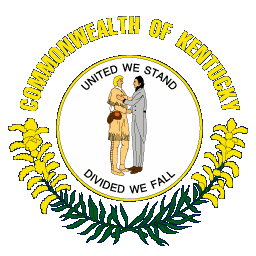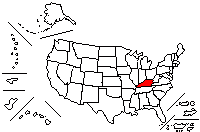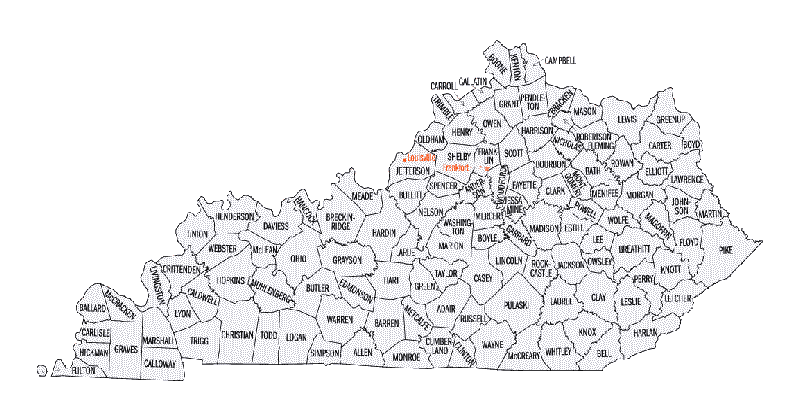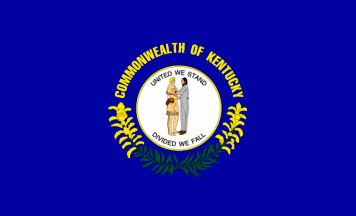
 |
|

















My Old Kentucky Home |
Mi Viejo hogar de Kentucky |


Flag:
Flag:
Placed on a navy blue field is the seal and words "Commonwealth of Kentucky".
The two friends shaking hands, a pioneer and a statesman,
represent all the people. They are acting out the meaning of Kentucky's motto:
"United We Stand; Divided We Fall". Sprays of the state flower {goldenrod}
extend in a half circle around the picture. Flag adopted 1918 amended in 1928 & 1962.
Bandera:
Colocado en un campo azul marino está el sello con las palabras "Commonwealth of Kentucky"
(Comunidad o República de Kentucky). Los dos amigos dandose un apretón de manos, un pionero y
un hombre de estado, representa todas las personas de Kentucky. Ellos están actuando como
Lema dice "Unidos nos sostendremos, divididos caeremos". La flor del estado (Varadorada)
se extiende a mitad del circulo al rededor de dibujo. La bandera fué adoptada en el
1918 y emendada en el 1928 y 1962.

Kentucky:
Kentucky (se pronuncia Ken-tóc-ky en inglés y español)
Capital City: Frankfort
National: Kentuckians
Admission to Statehood: June 1, 1792
Motto: United we stand, divided we fall
This familiar motto paraphrases a line from John dickinson’s “Liberty Song of 1768,”
which says “By uniting we stand;
by dividing we fall.” George Pope Morris, who wrote the poem “The Flag of
Our Union,” probably got the phrase from the original song.
Nickname: Bluegrass State
Origin of state's name: Named by USA Citicenz. Based on the Iroquois Indian word "Ken-tah-ten,"
meaning "land of tomorrow"
Ciudad Capital: Frankfort (Fuerte Frank)(se pronuncia fránk-for-rt en inglés y español)
Gentilicio: Kentuckianos
Admición como estado: 1 de junio de 1792
Lema: Unidos nos sostendremos, divididos caeremos
Este familiar lema parafrasea una linea de John dickinson’s “Liberty Song of 1768,” (Canción de
la Libertad de 1768) el cual dice “By uniting we stand;
by dividing we fall.” (Por unirnos nos sostendremos, por dividirnos caeremos). George Pope Morris
quien escribió un poema “The Flag of
Our Union,” (La Bandera de Nuestra Unión) probablemente tomó la frase de esa canción.
Cognómento: El Estado del pasto azul
Origen del Nombre: Nombre dado por ciudadanos americanos. Basado en la palabra india Iroquois
"Ken-tah-ten," que significa "Tierra del Mañana".


The Seal:
Kentucky's official seal was adopted in 1792, six months after Kentucky gained statehood.
The seal is a simple rendition of two men, one in buckskin, and the other in more formal
dress. The two men are facing each other and clasping hands. The outer ring of the seal is
adorned with the words "Commonwealth of Kentucky", and within the inner circle is the motto
"United we stand, Divided we fall."
The official act of the General Assembly in December 1792 stated: Be it enacted by the
General Assembly, that the Governor be empowered and is hereby required to provide at the
public charge a seal for this Commonwealth; and procure the same to be engraved with the
following device, viz; 'Two friends embracing, with the name of the state over their heads
and around about the following motto: United we stand, divided we fall."
The two men on the seal haven't stood still for two centuries, however. Various
versions have pictured both men dressed in buckskin, or both men in formal dress,
men with and without hats, men with beards, men with wigs, and hand clasps that have
ranged from simple handshakes to full embraces.
El Sello
El sello oficial de Kentucky fué adoptado en el 1792, seis meses después que obtubo la estadidad.
El sello es una simple presentación de dos hombres, uno en vestimenta de cuero y el otro en
una vestimenta más formal. Los dos hombres están cara a cara y apretando sus manos. El anillo
exterior del sello está adornado con las palabras "Commonwealth of Kentucky" (Comunidad de Kentucky
o República de Kentucky), y dentro del circulo interior está el lema "Unidos nos sostendremos,
Divididos caeremos".
El acta oficial de la Asamblea General en diciembre de 1792 dictaminó: Estar representado por
la Asambela General, que el Gobernador está autorizado y por este medio es requerido proveer
en el cargo público un sello para esta comunidad; y procurar que el mismo sea tallado con las siguientes
esquema: Dos amigos abrazados, con el nombre del Estado sobre sus cabezas y al rededor el siguiente
lema: Unidos nos sostendremos, divididos caeremos".
Los dos hombres en el sello no han cambiado por dos siglos, sinembargo, varias verciones tienen
dibujados ambos hombres vestido con vestimenta de cuero, o ambos hombre en vestimenta formal,
hombres con y sin sombreros, hombres con barbas, hombres con pelucas, y el apretón de manos se ha cambiado
por un completo abrazo.

HISTORY
Kentucky presents a mixture of both the Midwest and the South.
The northern, more urban portion of the state, particularly
the Ohio Valley corridor, is characterized by manufacturing
and is oriented to the Midwest. Southern and western Kentucky
tend to be rural in nature, concentrating on agriculture and
mining; they are generally associated with the South. The state's
abundant natural resources, scenic beauty, historic sites and other
treasures, and its proud people contrast with Kentucky's problems
of poverty, poor housing, and low levels of education.
Kentucky is centrally located within the eastern United States,
bordered by the seven states of Illinois, Indiana, Ohio, West Virginia,
Virginia, Tennessee, and Missouri. The state has an extreme width
of 290 km (180 mi) and a length of 676 km (420 mi). Kentucky was
once an Indian hunting ground. The name is believed to come from
an Indian word meaning "prairie." White men had explored the area
by 1750. In 1792, Kentucky separated from Virginia to become the 15th state.
Indians established civilizations in Kentucky more than 13,000
years ago. When the first white people entered the area, it was
being used as a hunting ground by the Shawnee and Cherokee Indians.
One of the early explorers, Dr. Thomas Walker, entered Kentucky after
discovering Cumberland Gap in 1750. The gap provided a relatively
easy route through the Cumberland Mountains, and in subsequent years
countless explorers and settlers were to move through it. One of the
best-known explorers was the legendary Daniel Boone, who first arrived in 1767.
Others reached Kentucky via the Ohio River and established settlements
at Maysville and Louisville.
The first settlement of Fort Harrod, now known as Harrodsburg, was es
tablished by James Harrod in 1774. Boonesborough was settled in 1775 by
Daniel Boone and his companions. Increased settlement brought pressures
for statehood. Following conventions in Danville, the first constitution
was approved in April 1792; Kentucky became the 15th state on June 1, 1792.
In what was essentially a compromise between Lexington and Louisville,
Frankfort was selected the state capital. The new state legislature
adopted a strong state rights position when it adopted (1798) resolutions
opposing the Alien and Sedition Acts
Between statehood and the Civil War, Kentucky increased its population
from about 75,000 to more than 1 million. Slavery became the dominant
social and political issue as the state expanded its farm production.
An agricultural market downstream on the Mississippi River was assured
by the Louisiana Purchase in 1803. The steamboat provided transportation
on the Ohio River by 1815, and a rail system was developed before 1860.
A border state, Kentucky attempted to remain neutral during the Civil
War but was unsuccessful because of its strategic location and the divided
loyalties of its citizens. Farmers who used the Ohio and Mississippi
rivers for transporting their produce wanted access to both waterways
and the international port of New Orleans. If the South separated itself
from the North, this free access would be impeded. On the other hand,
influential plantation owners and state rights advocates sided with the
Confederacy. As a result, Kentuckians could be found in both Union and
Confederate armies. Confederate forces invaded Kentucky in 1861. Most
of the fighting within the state's boundaries, however, had ceased by 1863,
after the Confederate army was driven out.
After the Civil War, the state changed economically and socially.
Tobacco replaced hemp as the major agricultural crop. Coal mining was
stimulated by the extension of rail lines into the coalfields of the
eastern part of the state. Increased employment opportunities arose in
manufacturing and services, and the major cities grew rapidly. After 1920
the state began a 70-year trend of decreases in rural population and growth
in urban areas.
Kentucky presenta una mezcla del Cercano oeste y del sur. La porción
norteña, más urbana del estado, particularmente el pasillo del valle
de Ohio, es caracterizada fabricando y orientada al Cercano oeste.
Kentucky meridional y occidental tiende para ser rural en la
naturaleza, concentrándose en agricultura y minaería; se asocian
generalmente al sur. Los recursos naturales abundantes del estado, la
belleza escénica, los sitios históricos y otros tesoros, y su gente
orgullosa ponen en contraste con los problemas de Kentucky de la
pobreza y de los niveles de la educación
bajos. Kentucky centralmente está situado dentro de los Estados
Unidos del este, rodeados por los siete estados de Illinois, de
Indiana, de Ohio, de Virginia del oeste, de Virginia, de Tennessee, y
de Missouri. El estado tiene una anchura extrema de 290 kilómetros
(180 millas) y de una longitud de 676 kilómetros (420 millas).
Kentucky era una vez un coto de caza del indio. El nombre se cree
pudo venir de una palabra india que significava "pradera" Los
hombres blancos habían explorado el área antes de 1750. En 1792,
Kentucky se separó de Virginia para convertirse en el décimo quinto
estado.
Los indios establecieron civilizaciones en Kentucky
hace más de 13.000 años. Cuando la primera gente blanca entró en
el área, era utilizada como coto de caza por el Shawnee y los indios
cherokee. Uno de los exploradores, el Dr. Thomas Walker,
entró en Kentucky después de descubrir el desfiladero de Cumberland en
1750. El desfiladero proporcionó una ruta relativamente fácil a través
de las montañas de Cumberland, y en años subsecuentes los
exploradores y los incontables colonos debían moverse a través de
ella. Uno de los exploradores más conocidos fué el legendario Daniel
Boone, que primero llegó en 1767. Otros alcanzaron Kentucky vía el
río de Ohio y establecieron en Maysville y
Louisville. El primer establecimiento de Fuerte Harrod, ahora
conocido como Harrodsburg, fué establecido por James Harrod en 1774.
Boonesborough fué fundado en 1775 por Daniel Boone y sus
compañeros. El establecimiento creciente trajo presiones por la
statehood. Después de convenciones en Danville, la primera
constitución fue aprobada en abril de 1792; Kentucky se convirtió
en el décimo quinto estado el 1 de junio de 1792. En lo que fué
esencialmente un compromiso entre Lexington y Louisville, Frankfort
fue seleccionado la Capital del Estado. La nueva legislatura de
estado adoptó una posición fuerte de las derechas del estado cuando
adoptó (1798) resoluciones que oponían los actos del extranjero y de
la sedición
.
Entre la estadidad y la guerra civil, Kentucky aumentó a su
población de cerca de 75.000 a más de 1 millón. La esclavitud se
convirtió en la asunto social y política dominante mientras que el
estado amplió su producción de la granja. Un mercado agrícola río
abajo en el río de Mississippi fué asegurado por la compra de
Luisiana en 1803. Las embarcaciones a vapor proporcionó el transporte en el río
de Ohio antes de 1815, y un sistema de ferrocarril fue desarrollado antes
de 1860. Un estado fronterizo, Kentucky procuró seguir siendo
neutral durante la guerra civil pero fué debido a su
localización estratégica y las lealtades divididas de sus
ciudadanos. Los granjeros que utilizaron los ríos de Ohio y de
Mississippi para transportar su producto desearon el acceso a los
canales y al puerto internacional de New Orleans. Si el sur se
separara del norte, este acceso libre sería impedido. Por otra
parte, los dueños de la plantación e influyentes abogados fueron al lado con el Confederación.
Consecuentemente,
Kentuckeños se podía encontrar en ejércitos de la unión y del
confederato. Las fuerzas confederadas invadieron Kentucky en 1861.
La mayoría lucharon dentro de los límites de estado, sin embargo,
había cesado antes de 1863, después de que condujeran al ejército
confederado hacia fuera. Después de la guerra civil, el estado
cambió económicamente y socialmente. El tabaco substituyó cáñamo
como la cosecha agrícola principal. La explotación del carbón fué
estimulada por la extensión de las líneas del ferrocarril en las cuencas
carboníferas de la parte del este del estado. Las posibilidades de
empleo crecientes se presentaron en la fabricación y servicios, y las
ciudades principales crecieron rápidamente. Después de 1920 el
estado comenzó una tendencia 70-year de disminuciones de la
población rural y del crecimiento en áreas urbanas.
